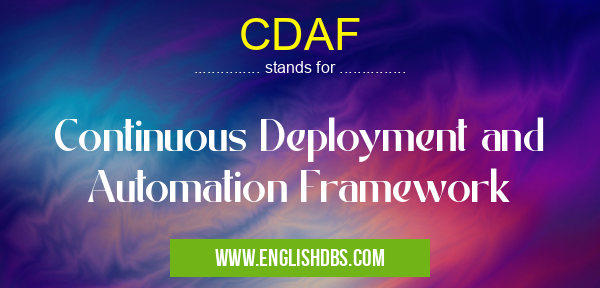What does CDAF mean in UNCLASSIFIED
Implementing CDAF involves several key steps:

CDAF meaning in Unclassified in Miscellaneous
CDAF mostly used in an acronym Unclassified in Category Miscellaneous that means Continuous Deployment and Automation Framework
Shorthand: CDAF,
Full Form: Continuous Deployment and Automation Framework
For more information of "Continuous Deployment and Automation Framework", see the section below.
Key Features of CDAF
- Continuous Integration: Code changes are automatically merged into a central repository, triggering automated builds and tests.
- Automated Testing: Automated unit, integration, and performance tests are executed to ensure code quality.
- Continuous Deployment: Changes are automatically deployed to production environments after passing tests.
- Automation: Scripts and tools automate various tasks, such as code analysis, deployment, and monitoring.
- DevOps Collaboration: Fosters collaboration between development and operations teams throughout the development lifecycle.
Benefits of CDAF:
- Faster Delivery: Continuous deployment reduces lead times for software releases.
- Improved Quality: Automated testing ensures consistent code quality, reducing defects.
- Increased Efficiency: Automation eliminates repetitive tasks, freeing up teams for more strategic work.
- Reduced Risk: Automated deployment minimizes human errors and ensures consistent environments.
- Enhanced Collaboration: DevOps collaboration improves communication and aligns goals between development and operations.
Implementation of CDAF:
- Establish a CI/CD Pipeline: Implement a continuous integration and deployment pipeline using tools like Jenkins or Azure DevOps.
- Automate Testing: Integrate automated unit, integration, and performance tests into the pipeline.
- Integrate Deployment Tools: Use tools like Terraform or Ansible to automate deployment to different environments.
- Monitor and Measure: Implement continuous monitoring tools to track progress and identify areas for improvement.
Conclusion:
CDAF is a powerful framework that transforms software development and delivery by combining continuous deployment and automation. It enables faster, more reliable, and more efficient software releases, ultimately enhancing productivity and delivering value to organizations. By embracing CDAF, businesses can stay competitive in the rapidly evolving technological landscape.
Essential Questions and Answers on Continuous Deployment and Automation Framework in "MISCELLANEOUS»UNFILED"
What is the Continuous Deployment and Automation Framework (CDAF)?
CDAF is a framework that helps organizations implement continuous deployment and automation practices in their software development processes. It provides guidance on how to plan, design, and implement a continuous deployment pipeline, and how to automate testing, deployment, and monitoring tasks.
What are the benefits of using CDAF?
CDAF can help organizations improve their software development processes by:
- Reducing the time and effort required to deploy new software updates
- Improving the quality of software releases
- Increasing the frequency of software updates
- Reducing the risk of software defects
How do I get started with CDAF?
The first step is to assess your current software development process and identify areas where you can improve. Once you have identified areas for improvement, you can start to implement the CDAF framework. CDAF provides guidance on how to:
- Plan your continuous deployment pipeline
- Design your automated testing and deployment processes
- Monitor your software releases
What are some of the challenges of implementing CDAF?
Some of the challenges of implementing CDAF include:
- Cultural resistance to change
- Lack of technical expertise
- Integration with existing systems and processes
Where can I find more information about CDAF?
You can find more information about CDAF on the following websites:
CDAF also stands for: |
|
| All stands for CDAF |
